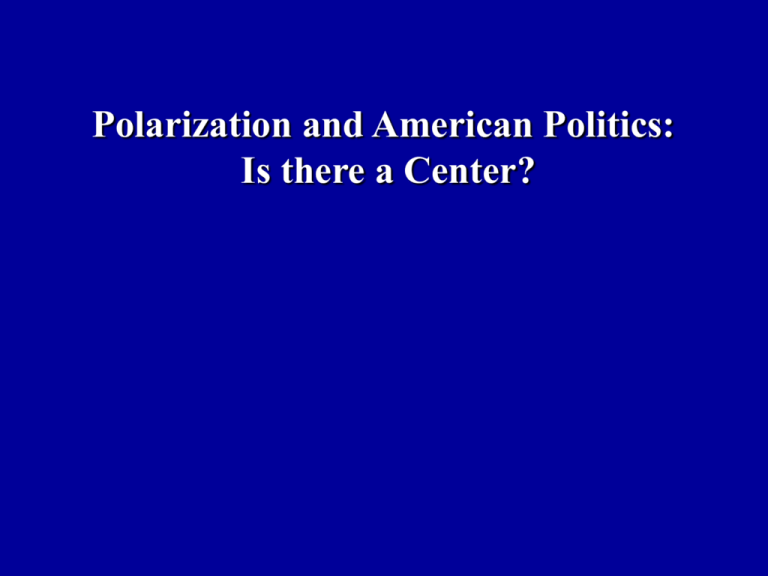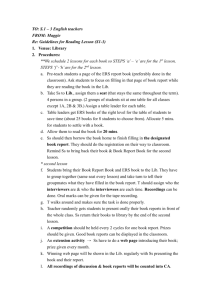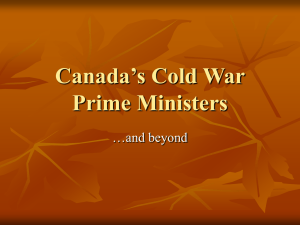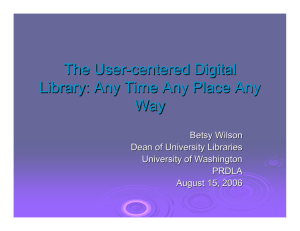The Electorate in 2004
advertisement

Polarization and American Politics: Is there a Center? Polarization Argument • Few moderates in electorate (is this true?) • Partisanship plays greater role in mass voting • Partisanship plays greater role in Congress • Party candidates stake out more clear ideological differences • “Culture war,” Red v. Blue nation, etc. The Electorate, 1974 40 35 30 25 gop 20 dem 15 10 5 0 ex lib lib sl lib mod, mid sl con con ex con Ideological self-placement of partisans. Percent w/in each group The Electorate in 2004 40 35 30 25 gop 20 dem 15 10 5 0 ex lib lib sl lib mod, mid sl con con ex con Ideological self-placement of partisans. Percent w/in each group Polarized Partisans & Elites • Partisans “sorting themselves” • Gradual realignments since 1968 • Demise of southern Democrats • Demise of New England Republicans • Transition from economic to social issue divisions • Institutions should reflect polarization Party Unity in US House Floor Votes, 1960 - 2000 100 proportion of all floor votes with majority of one party against majority of the other 60 % of Democrats voting with party on such votes % of Republicans voting with party on such votes 40 Year 2000 1990 1980 20 1970 percent 80 GOP trends since 1974 40 35 30 25 gop74 gop84 20 gop94 gop04 15 10 5 0 ex lib lib sl lib mod, mid sl con con ex con Ideological self-placement of Republicans (excluding leaners) Dem trends since 1974 40 35 30 25 dem74 dem84 20 dem94 dem04 15 10 5 0 ex lib lib sl lib mod, mid sl con con ex con Ideological self-placement of Democrats (excluding leaners) Polarization, 109th Congress 70 60 50 40 30 20 10 0 .9 - 1 .8 - .9 .7 - .8 .6 - .7 .5 - .6 .4 - .5 .3 - .4 .2 - .3 .1 - .2 0 - .1 0 - .1 .1 - .2 .2 - .3 .3 - .4 .4 - ,5 .5 - .6 .6 - .7 .7 - .8 .8 - .9 1 - .9 Number of seats; classified by DW-Nom member’s voting score Feelings about 'opposite' party's presidential candidate (thermometer scores) 60 55 50 dem_goppres gop_dempres 45 40 35 30 2004 2000 1996 1992 1988 1984 1980 1976 1972 1968 Graph plots trends in Democratic identifiers’ feelings about Republican presidential candidates and Republican identifiers feelings about Democratic presidential candidates. Gap between Democrats and Republicans' Feelings toward Republican candidates for Congress. diff_re:demcong 20 18 16 14 diff_re:demcong 12 10 8 6 2004 2002 2000 1998 1996 1994 1992 1990 1988 1986 1984 1982 1980 1978 Graph plots the gap between Democrats feeling thermometer ratings of Republican candidates, and Republican’s scores about Republican candidates. When seen this way: Evidence of growing Polarization Partisan voters more partisan Partisan representatives more partisan But what about every one else Independents? Another Picture of Electorate Retreat from parties and party system (dealingment): • More independents • Independents qualitatively different than partisans • Little mass support for two-party system • Polarization an artifact of electoral system (safe seats & where people live…) The Electorate, 1974 40 35 30 25 gop 20 ind dem 15 10 5 0 ex lib lib sl lib mod, mid sl con con ex con Ideological self-placement of ‘everyone’. Percent w/in each group A Centered Electorate, 2004? 40 35 30 25 gop 20 ind dem 15 10 5 0 ex lib lib sl lib mod, mid sl con con ex con Ideological self-placement of ‘everyone’. Percent w/in each group The Electorate in 2004 14 12 10 8 gop ind 6 dem 4 2 0 ex lib lib sl lib mod, mid sl con con ex con Moderate Independents 26% of electorate (largest block) Ideological self-placement of ‘everyone’. Proportion of electorate Independents, 1952 - 2004 40 35 30 Ind, Lean D Ind. Ind, Lean R Total Ind. 25 20 15 10 5 2004 2000 1996 1992 1988 1984 1980 1976 1972 1968 1964 1960 1956 1952 Responses to initial NES question, “Generally speaking…..” Independents, since 1974 40 35 30 25 ind74 ind84 20 ind94 ind04 15 10 5 0 ex lib lib sl lib mod, mid sl con con ex con Ideological self-placement of independents (including leaners) 2008: The Electorate • 40% (plurality of Americans identify as independent) • 40% of independents (who respond) ID as “moderate” “ middle” • 25% of all Americans (who respond) ID as “moderate” “middle” • 22% ID as “liberal” • 32% ID as “conservative” Change since 1974 More GOP conservatives in Congress More liberal Democrats in Congress Fewer Democrats and Republicans in the electorate Polarization without partisans Without meaningful political competition Reform Goals 50 yrs ago: Build Responsible Parties • 1950s, Problem: weak, incoherent parties, lack of accountability • 1950s Reform goals Cohesive, ideologically distinct parties Party unity in legislature Greater party role in campaign finance Closed nominations (no blanket primary) Rank and file partisans select conv. delegates Greater role of policy in (national) campaigns Responsible Party Model APSA report also noted: End one party rule that renders elections meaningless in much of nation End electoral college that renders elections meaningless in much of nation 0.25 0.2 0.15 0.1 2010 2000 1990 1980 1970 1960 1950 1930 1920 1910 1900 0 1940 0.05 1890 Proportion seats won with less than 5% margin Decline of Competition, US House 1898 - 2000 Year Proportion of House seats won by 5% or less Incumbent Victory Margins: 1898 - 2000 0.5 0.4 0.3 DemMargin GOPMargin 0.2 0.1 Year 2000 1990 1980 1970 1960 1950 1940 1930 1920 1910 1900 1890 0 Representation and Competition 11 0.58 19 40 57 52 22 4 26 0.38 0.18 85-100 R 80-85 R 75-80 R 70-75 R 65-70 R 60-65 R 55-60 R 14 50-55 R 50-55 D 55-60 D 60-65 D 65-70 D 70-75 D 75-80 D 80-85 D -0.22 Series1 85-100 D -0.02 20 -0.42 35 -0.62 13 30 49 30 12 Jan. 2005 - Dec 2006, by type of district. (109th Cong) Party Discipline w/o Competition • High levels of cynicism about politics – 43% agree, ‘people have no say’ in 2004 – 27% agreed ‘people have no say’ in 1960 – 56% agree ‘elected officials don’t care’ in 2004 – 25% agreed officials don’t care in 1960 • Decline in turnout (?) Are these trends related? Parties are now much more cohesive: • Soft money, fundraising post BCRA • Congressional floor voting discipline • Party leaders (in Govt.) more power • Activists dominate presidential nominations Politics, media more partisan, more polarized Electoral competition often meaningless (swing, safe seats) Fewer partisans, engagement with politics down Public Views of Elections & Parties • Less than 1/3 support maintaining two party system • Few think that elections make government pay attention • Turnout stagnant (down in north) despite fewer barriers Do Elections Matter? 80 70 60 dem_electsmat ind_electsmat gop_electsmat 50 40 30 20 2004 2000 1996 1992 1988 1984 1980 1976 1972 1968 1964 Trends in responses to NES q; Do elections make govt pay attn? Do Elections Matter? Growing cynicism & low efficacy about elections • Pre-dates 2000 election disaster • Pre-dates recently lobbying scandal • Unlikely to be affected by HAVA like reforms Do Elections Matter How honest vote counting (% very dishonest, 2004): US 23% Venezuela 18% Taiwan 16% Mexico 13% Philippines 12% S Africa 8% Bulgaria 8% Slovakia 7% Chile 6% Russia 5% PR, PO, JP, SW, SK, AU, GB NE, CA, FN, NZ, NO lt 1% What problem should election reforms target? • “faith in elections” • “public trust” • “have elections express will of the people” • engagement with representative democracy • participation • polarization w/o partisans, w/o competition Make Elections Worth Stealing Assume the ‘perfect’ election under HAVA - type reforms polling places, early voting, registration…. Assume just one candidate has a chance to win …. Will HAVA reforms affect anything? Make Elections Worth Stealing If you build it, they will come… Electoral competition -> representation of ‘center’, median Electoral competition -> alter composition of electorate Electoral competition -> interest, learning, participation Electoral competition -> accountability, change in govt. Electoral competition -> over crowded polling locations, more Florida 2000, cheating, etc. Larger Questions How much should government & elections represent those care the least about politics? Will more competition make people upset? How much does political apathy is due to the dysfunctional aspects of institutions? What reforms?





